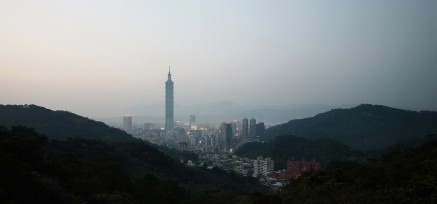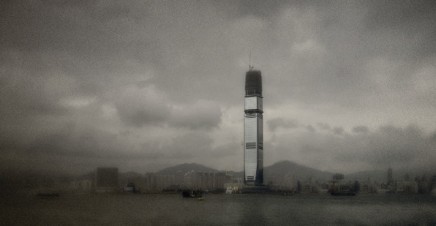
Is architectural photography art photography?
January 21, 2010This is a revised and expanded version of a post for a blog/assignment I briefly flirted with, Artificial Infinite. This essay is part of my research into the history and interpretation of architectural photography, presenting its current dilemma primarily through the work of one contemporary photographer, Tim Griffith. In this post I’m proceeding from the premise (whose defense I don’t think I need to really mount here in detail) that today both architecture and photography are in their own states of disarray and redefinition, making their current fusion especially fluxy. I also changed the title of the post to pose a question, for which there may be numerous answers beyond “yes” and “no.”
Upon its inception, the photograph—the “fixed image” (recalling this phrase’s wet-plate process origin, the point at which an image must be chemically stopped and fixed in its development before it flees)—was popularly thought to be a way of suspending time and freezing motion, but it has always been key to conveying the inanimate built environment too. Photography—whose first and arguably true muse is architecture—liberated impassive and stationary buildings from their physical bounds to the ephemeral realm of the image. The mastery of photomechanical reproduction in the 1890s allowed these images to wander as far across the globe as commercial means could take them.
But that was then. Architect and theorist Kazys Varnelis proposed that architectural photography has increasingly divorced itself from its ostensible subject.
To be sure, photographers, particularly members of the Frankfurt School such as Andreas Gursky, Laurenz Berges, Thomas Ruff, and Thomas Struth (and with even if he is an exception due to the constructed nature of his environments, Thomas Demand), have given new, sustained focus on architecture as a subject. Architecture, in this sense, becomes not a matter to represent, but rather a way to represent the delirium of globalized space today.
A degree of category confusion is introduced at this point, because the photographers Varnelis cites are primarily considered “art” photographers—the gallery system, curatorial authority, and a collector base dictate their industry (he probably also means the Düsseldorf School). But even in the post-postmodern tech+culture realm about which Varnelis lectures and writes, “architectural photography” proper still connotes a traditional client-driven practice straddling the architecture and publishing industries.
Architectural photography’s place of distinction in the contemporary visual environment is due to an apparent paradox: that for all its overwhelming physicality and spatiality, architecture has always been primarily experienced with the sense of sight. Humans are more mobile than ever before, yet we can never attend physically all that is within range visually. Architecturally voracious, our eyes are not just confronted by immediate built environments and distant skylines, but the continued propagation of images of buildings in a superabundant visual environment: online, in books, magazines, and other visual media.
As architecture evolved from a gentlemanly pursuit in the nineteenth century to a codified industry in the twentieth, photography’s role became critical to popularizing new development. During the era of high modernism, projections into the future near and far proliferated; radical new forms were introduced to the industry and the general public through trade and lifestyle publications, and photographs were key to the aims of the development and real estate sectors. Many of these photographers first trained as architects, and its practitioners achieved the status of specialist-experts, resulting in a putative opposition between “true practice” and “mere commerce.”
Architect-cum-photographer Joseph Molitor was a prime exponent of this self-accredited connoisseur outlook, down to the name of his signature monograph from 1976, Architectural Photography. “Granted an architectural photograph must truly interpret the structure; what else distinguishes a good architectural photograph from a good commercial one?” he asked, rhetorically reinforcing the professional gulf. His rules—foregrounding, dramatic perspective, optimizing texture through shadows, balancing isolation and environmental context of the subject, housekeeping both of environment (wires, cars, etc.) and interiors, balancing light, and creating excellent print quality—were characteristic of an era when buildings were hallmarks of an assertive modernist moment; a few years later such prescriptions could no longer obtain in a built landscape under heavy torsion from postmodernism and deconstructivism.
Varnelis indeed points to a notable development: the current practice of architectural photography has in many ways evolved toward artistic effect. Photographers such as Iwan Baan and Frank van der Salm are today regularly tapped by the titans of the architecture industry—OMA, Herzog & de Meuron—to create photographs whose mannerisms and ellipses seem to violate most of Molitor’s tenets.
A brief exploration of the work of contemporary architectural photographer Tim Griffith provides a case study of this emergent “artistic” approach to architectural imaging and the shifting state of practice today. Giffith’s work, included in the 2009 Ballarat International Foto Biennale, depicts some of the most prominent architectural projects of our age. Griffith presents the tensions inherent in this yoking of architecture and photography; his work is formed by professional rigor yet inflected toward art, hypertechnological in subject and approach, yet suggestive of an already fading moment.
The portraits of this iconic generation of state- and corporate-sponsored architecture would not at first flush seem to fall within the classical rules. Yet his approach to the new canon of recent technological structures—the CCTV Headquarters, the Beijing National Stadium, Taipei 101—is not unlike that of any classical architectural photographer who must recognize and visually communicate a building’s exoteric and esoteric values both. He still devotes attention to timeless architectural qualities of strength, character, stillness, and formality through the paradoxical strategy of rendering these megaprojects diaphanous, immaterial, scaleless, unguarded. Griffith shows it is possible to attend the norms of conventional architecture photography while also subverting them, within the foursquare of the very image. Griffith’s pictures can also be read as history and augury of architectural photography as a specialized practice.
Whereas many artists conventionally take up the most obvious capacity of the camera and explore the range, nature, and effects of light, Griffith delves into the subtler and more arcane functions of time in the architectural subject and the photographic image. As the camera, in its inception, could reveal realms previously invisible to the human eye through varying exposure times, magnifications, and chemical processes, it was imputed to have pseudomystical properties: the ability to see through dimensions, and even into the realm of the dead. It could be a time machine.
These monumental projects and newly minted urban vistas are more than just reflections of the present moment; they are intricate bundles of temporality. The past tenaciously seems to outpace the present (there has been a series of four World’s Tallest buildings in the past decade). But moreover, the inherent future is already relegated to decay. Subject to elaborate design, construction, and publicity cycles, these megaventures are presented as “iconic” before they exist, and are outmoded by the time they are topped off. “Out of scale” beyond a preservationist’s nightmare, they are born into an urban and economic context that cannot assimilate them. Griffith’s images often take these monumental presences at a distance, producing vistas where the master edifice aggressively obtrudes—or in some cases, as in Taipei 101, causing the recent World’s Tallest record-holder to recede almost to quaintness.
The immanence of the ruin within these half- and newly built projects pervades Griffith’s work. It is impossible to consider these images without thinking of the economic atmosphere that produced them. If these edifices are indeed icons, perhaps the status to which they will forever aspire is an iconic ambivalence, a stage hovering between boom and bust, an apprehensive liminality. In some ways, these are monuments to a worldview that has already passed. Griffith’s photographic methodology affirms this uncertainty; the scenes are captured with large-format cameras with high-resolution digital sensors and the resulting information—pristine and finely detailed—subsequently exposed to a series of processes to degrade the image. The resultant disorienting pictorialist scrim imparts an ephemeral sense to these buildings, offering them less as icons of the future than memorials to an interrupted civilization.
The conventions of architectural photography were inculcated by the ruin from the earliest days of the practice. In Building With Light: An International History of Architectural Photography, Robert Elwall writes: “Apart from such major projects as the Crystal Palace in London or the new Louvre in Paris, it is immediately striking how few contemporary buildings were photographed during the medium’s initial decades.” Early photography’s ruin fetish is due to coinciding events of the era: the prevailing classical architecture revival of the time, and the rise of souvenir photography from Greek and Roman sites in the middle east opened up by the Napoleonic crusades. Some of Griffith’s images echo this history, exuding the quality of hand-tinted travel postcards from the Age of Empire, dreamlike documents illuminating exotic marvels of the world. Without the kind of cues found in conventional professional architectural photography that tell us when and where the subjects are situated, images such as One and Birdsnest could be respectively the ruins of a near-future Gothic Cathedral or Taj Mahal. Griffith’s visual tactics presage the inevitable decay of these structures.
At the conclusion of Architectural Photography, Molitor writes
Someday another [pioneering architectural photographer Ken] Hedrich will come along and view architecture entirely differently than any of us today, and then architectural photography will enter its diamond age. Perhaps the architects themselves will bring this about by coming up with such dramatic changes in design that a whole new concept of photography will be necessary to record it properly.
The work of Tim Griffith and his contemporaries may be an incomplete rejoinder to Molitor’s speculation, but their images intimate that this Diamond Age is now upon us.





Great post Alan. Thanks.
Kimo
Hello, I really appreciated your debate on architectural vs. fine art. I have been deliberating upon this a lot with my own work and have encountered professionals whose feelings fall strongly to one side or another. My own belief is that a successful photographic portrait of a structure is a collaboration, in a sense, between photographer and building (and / or architect). The building itself encapsulates a certain argument, concept, and age, and how the picture captures or doesn’t capture this creates a document both conceptual and documentary.
i think what is equally important to discuss and question is whether or not this act of photography is further removing the idea of architecture as a fluid, complex set of structures and turning it into what I recently tried to argue in an essay an ‘object’ within the photographic frame.
ie the the photography of architectural objects
[…] the image’s primary role in the practice and perception of architecture today. As mentioned before, architectural photography—where space and the image intersect—reveals the radical flux acting […]